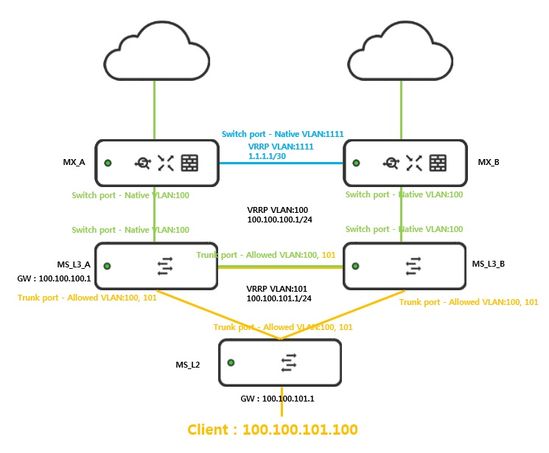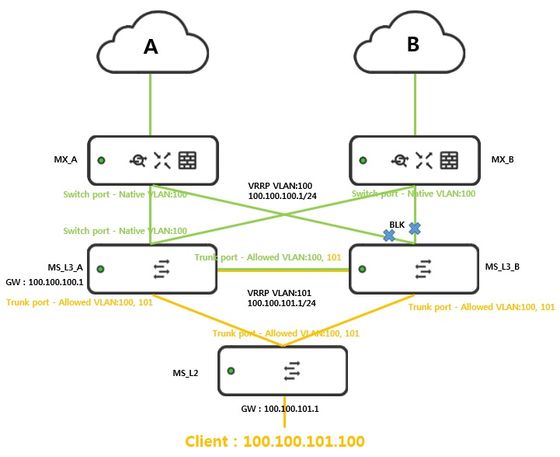Get answers from our community of experts in record time.
Join now- Technical Forums
- :
- Security & SD-WAN
- :
- Re: Meraki recommended design?
Meraki recommended design?
Solved- Subscribe to RSS Feed
- Mark Topic as New
- Mark Topic as Read
- Float this Topic for Current User
- Bookmark
- Subscribe
- Mute
- Printer Friendly Page
- Mark as New
- Bookmark
- Subscribe
- Mute
- Subscribe to RSS Feed
- Permalink
- Report Inappropriate Content
Meraki recommended design?
Hello,
I need a help with meraki design.
I have MX(2EA), MS_L3(2EA) and MS_L2(1EA).
I'm going to construct it as below. I want to know if it is the right design.
I want to get your advice.
-> I think... the above design has a problem when the link down.
How about the design below?
Solved! Go to solution.
- Mark as New
- Bookmark
- Subscribe
- Mute
- Subscribe to RSS Feed
- Permalink
- Report Inappropriate Content
The warm spare automatically gets the same local VLAN and interface config.
In an L3 CORE design, just have a transit VLAN that is a /29 or lower because you need at least 3 IP's for your switches in a stacking scenario and 1 IP for the uplink MX. Use access ports on the switches connecting to the MX'es.
In an L2 CORE design, use trunks between the switches and the MX'es and use one of the configured VLAN on the MX as native VLAN on those trunks because you should not "drop untagged" traffic because STP BPDU's are sent untagged and I have seen four links in forwarding state due to this.
- Mark as New
- Bookmark
- Subscribe
- Mute
- Subscribe to RSS Feed
- Permalink
- Report Inappropriate Content
Your 2nd is the meraki recommended.
The other option would be stacking the switches.
- Mark as New
- Bookmark
- Subscribe
- Mute
- Subscribe to RSS Feed
- Permalink
- Report Inappropriate Content
Hi,
I have already read this document.
However, there is no explanation for subnet separation in the document.
If I'm configured as a mesh, like a document, should I all take the same subnet.
If configured in the same subnet, two spanning tree block ports occur.
Is this right?
- Mark as New
- Bookmark
- Subscribe
- Mute
- Subscribe to RSS Feed
- Permalink
- Report Inappropriate Content
Personally I'd stack the L3 switches. Then there is no VRRP and only a single spanning tree instance.
I no longer dual connect MXs. So I'd be creating a single connection from each MX to its nearest switch, with no link between the MXs. Then everything is 100% loop free.
I've had more failures due to loops than through single cable or port failures.
- Mark as New
- Bookmark
- Subscribe
- Mute
- Subscribe to RSS Feed
- Permalink
- Report Inappropriate Content
You should indeed stack those switches but the physical design you should pursue is the bottom picture.
Always, always, ALWAYS... build your topology using triangles, not squares!
This is especially true if you want to use the inside switches to use on an external VLAN for the WAN side of your MX'es since you don't want complete fate sharing between router and switch and mx appliance.
- Mark as New
- Bookmark
- Subscribe
- Mute
- Subscribe to RSS Feed
- Permalink
- Report Inappropriate Content
@PhilipDAth wrote:Personally I'd stack the L3 switches. Then there is no VRRP and only a single spanning tree instance.
I no longer dual connect MXs. So I'd be creating a single connection from each MX to its nearest switch, with no link between the MXs. Then everything is 100% loop free.
I've had more failures due to loops than through single cable or port failures.
I dual connect them when I have a single MX connected to 9K cores, in case one of the cores goes down for whatever nightmare reason, the MX will continue to function =P
Spanning-Tree kicks in and have not had any issues, granted single MX again, so no VRRP worries on my side at least.
- Mark as New
- Bookmark
- Subscribe
- Mute
- Subscribe to RSS Feed
- Permalink
- Report Inappropriate Content
Thanks for all the answers.
We are unable to configure the stack at customer's request.
So I'm going to do it with Muraka's recommended design ...
I am wondering if it is correct to use the same subnet for both MX and MS configuration.
Recently, everyone is designing to avoid stp structure ...
In Meraki's recommended design, two spanning-tree blockports occur when all are on the same subnet.
finally..
When configuring MX and MS, is it the same subnet or different subnets?
- Mark as New
- Bookmark
- Subscribe
- Mute
- Subscribe to RSS Feed
- Permalink
- Report Inappropriate Content
Not sure whats your question. Mx cant use different vlans in warm spare.
Ms switches don't do pvst or hsrp to balance vlans. But rstp and vrrp. So ports will go in blocking.
- Mark as New
- Bookmark
- Subscribe
- Mute
- Subscribe to RSS Feed
- Permalink
- Report Inappropriate Content
I understand warm spare and rstp as you say.
I also understood that when configuring warm spares, all must be configured in the same subnet.
Thank you very much.
- Mark as New
- Bookmark
- Subscribe
- Mute
- Subscribe to RSS Feed
- Permalink
- Report Inappropriate Content
The warm spare automatically gets the same local VLAN and interface config.
In an L3 CORE design, just have a transit VLAN that is a /29 or lower because you need at least 3 IP's for your switches in a stacking scenario and 1 IP for the uplink MX. Use access ports on the switches connecting to the MX'es.
In an L2 CORE design, use trunks between the switches and the MX'es and use one of the configured VLAN on the MX as native VLAN on those trunks because you should not "drop untagged" traffic because STP BPDU's are sent untagged and I have seen four links in forwarding state due to this.
-
3rd Party VPN
166 -
ACLs
90 -
Auto VPN
291 -
AWS
36 -
Azure
67 -
Client VPN
369 -
Firewall
839 -
iOS
1 -
Other
541 -
Wireless LAN MR
1


